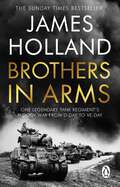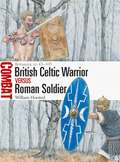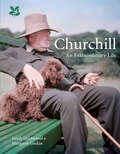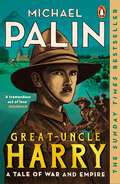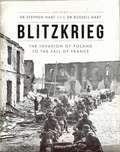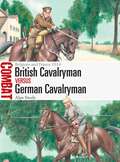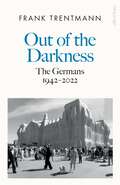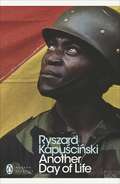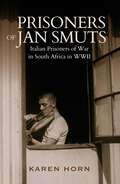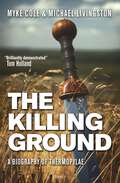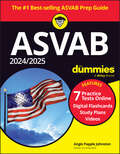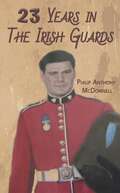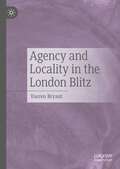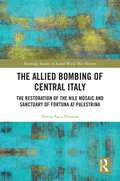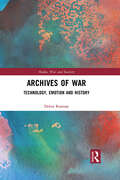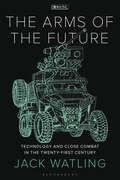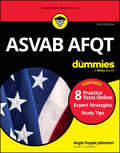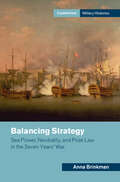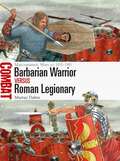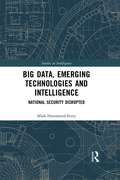- Table View
- List View
Brothers in Arms: One Legendary Tank Regiment's Bloody War from D-Day to VE-Day
by James HollandFrom the bestselling author of Normandy '44 and Sicily '43, a brilliant new history of the last days of the war'Seldom is war so vividly described...An assault on the senses...Painful to read, impossible to put down' Gerard DeGroot, The TimesIt took a certain type of courage to serve in a tank in the Second World War. Encased in steel, surrounded by highly explosive shells, a big and slow-moving target, every crew member was utterly vulnerable to enemy attack from all sides. Living - and dying - in a tank was a brutal way to fight a war.The Sherwood Rangers were one of the great tank regiments. They had learned their trade the hard way, in the burning deserts of North Africa. From D-Day onwards, they were in the thick of the action til the war's end. They and their Sherman tanks covered thousands of miles and endured some of the fiercest fighting in Western Europe. Their engagements stretch from the Normandy beaches to the bridges at Eindhoven. They were the first British unit into Germany, grinding across the Siegfried Line and on into the Nazi heartland.Through compelling eye-witness testimony and James Holland's expert analysis, Brothers In Arms brings to vivid life the final bloody scramble across Europe and gives the most powerful account to date of what it was really like to fight in the dying days of World War Two.
British Celtic Warrior vs Roman Soldier: Britannia AD 43–105 (Combat)
by William HorstedAn illustrated study of the British tribal warriors and Roman auxiliaries who fought in three epic battles for control of Britain in the 1st century AD. Following the Roman invasion of Britain in AD 43, the tribes of the west and north resisted the establishment of a 'Roman peace', led in particular by the chieftain Caratacus. Even in the south-east, resentment of Roman occupation remained, exploding into the revolt of Boudicca's Iceni in AD 60. Roman auxiliaries from two particular peoples are known to have taken part in the invasion of Britain: the Tungrians, from what is now Belgium, and the Batavians, from the delta of the River Rhine in the modern Netherlands. From the late 80s AD, units of both the Batavians and the Tungrians were garrisoned at a fort at Vindolanda in northern Britain. The so called 'Vindolanda tablets' provide an unparalleled body of material with which to reconstruct the lives of these auxiliary soldiers in Britain.Featuring full-colour maps and specially commissioned battlescene and figure artwork plates, this book examines how both the British warriors and the Roman auxiliaries experienced the decades of conflict that followed the invasion. Their recruitment, training, leadership, motivation, culture and beliefs are compared alongside an assessment of three particular battles: the final defeat of Caratacus in the hills of Wales in AD 50; the Roman assault on the island of Mona (Anglesey) in AD 60; and the battle of Mons Graupius in Scotland in AD 83.
Churchill: An Extraordinary Life
by Sarah Gristwood Margaret Gaskin National Trust BooksA short illustrated life of one of Britain's most revered people of all time, covering all periods of his life but always returning to his literal and spiritual home, Chartwell.
Great-Uncle Harry: A Tale of War and Empire
by Michael Palin'An important historical record and a well-paced story in its own right, Great-Uncle Harry is also much more than that: a tremendous act of love.' Guardian___________________________________From the time, many years ago, when Michael Palin first heard that his grandfather had a brother, Harry, he was determined to find out more about him.The quest that followed involved hundreds of hours of painstaking detective work. Michael dug out every bit of family gossip and correspondence he could. He studied every relevant official document. He tracked down what remained of his great-uncle Harry's diaries and letters, and pored over photographs of First World War battle scenes to see whether Harry appeared in any of them. He walked the route Harry took on that fatal, final day of his life amid the mud of northern France. And as he did so, a life that had previously existed in the shadows was revealed to him.Great-Uncle Harry is an utterly compelling account of an ordinary man who led an extraordinary life. A blend of biography, history, travelogue and personal memoir this is Michael Palin at his very finest.___________________________________________PRAISE FOR EREBUS:'Beyond terrific. I didn't want it to end.' BILL BRYSON'Magisterial . . . Palin brings energy, wit and humanity to a story that has never ceased to tantalise people.' THE TIMES'Everybody's talking about it . . . A brilliant book.' CHRIS EVANS'I absolutely loved it: I had to read it at one sitting.' LORRAINE KELLY
Blitzkrieg: The Invasion of Poland to the Fall of France
by Stephen A. Hart Russell HartA fascinating study of the devastating new form of warfare that redrew the map of Europe in the opening year of World War II, bringing about the military collapse of three modern industrialized armies. On 1 September 1939, Nazi Germany launched the invasion of Poland, employing a new type of offensivewarfare: Blitzkrieg. So named by Allied observers because of the shock and rapidity of its effects, this newapproach was based on speed, manoeuvrability and concentration of firepower. The strategy saw startlingsuccess as the panzer divisions, supported by Stuka dive-bombers, spread terror and mayhem, reachingWarsaw in just one week. Aided by the intervention of the Soviet Union in the east, the campaign was overin a mere 36 days.This astonishing feat was followed by Operation Weserübung, the invasion of Denmark and then Norway in1940, the first joint air-sea-land campaign in the history of warfare. Even more striking an achievement wasthe swift and conclusive defeat of France during May–June 1940. Refusing to let its forces dash themselvesagainst the fortifications of the Maginot Line, Germany instead sent its divisions through neutral Belgiumand northern France in Fall Gelb ('Case Yellow'), destroying Allied resistance and pursuing the remnant ofthe British and French forces to Dunkirk in an audacious and devastatingly effective assault. During thecourse of Fall Rot ('Case Red') over the following 20 days, German forces pressed the attack and by 25 Junehad forced France's leaders into a humiliating capitulation.Illustrated throughout with detailed maps, artwork and contemporary photographs, Blitzkrieg: TheInvasion of Poland to the Fall of France tells the story of these first breakneck attacks, examining the armedforces, leaders, technology, planning and execution in each campaign as well as the challenges faced by theGermans in the pursuit of this new and deadly form of warfare.
British Cavalryman vs German Cavalryman: Belgium and France 1914 (Combat)
by Alan SteeleFully illustrated, this book casts light on the utility and role of the German and British cavalry in the early stages of World War I on the Western Front.In the early months of World War I, before the fighting degenerated into static trench warfare, there was a brief period of mobile combat as the German Army advanced through Belgium and northern France, forcing the French and British forces facing them to retreat. Both sides in the escalating conflict deployed substantial numbers of cavalry units to screen their infantry forces, conduct reconnaissance and harness their superior mobility to undertake aggressive combat operations. In the summer of 1914, the British cavalry had the difficult task of covering the withdrawal of the British Expeditionary Force and the German cavalry, the equally demanding task, after weeks of combat and forced marches, of maintaining contact with a rapidly retiring enemy.In this book a comparative assessment is made of each side's doctrine, organization, equipment and training, followed by a detailed analysis of their actual performance in three key encounter actions: Casteau/Soignies (22 August), Cérizy/Moÿ (28 August) and Le Montcel/Frétoy (7 September). This analysis is supported by carefully chosen photographs and specially commissioned full-colour artwork and maps.
Out of the Darkness: The Germans, 1942-2022
by Frank TrentmannA groundbreaking new history of the people at the centre of Europe, from the Second World War to todayIn 1945, Germany lay in ruins, morally and materially. The German people stood condemned by history, responsible for a horrifying genocide and a war of extermination. But by 2015 Germany looked to many to be the moral voice of Europe, welcoming almost one million refugees. At the same time, it pursued a controversially rigid fiscal discipline and made energy deals with a dictator. Many people have asked how Germany descended into the darkness of the Nazis, but this book asks another vital question: how, and how far, have the Germans since reinvented themselves?Trentmann tells the dramatic story of the Germans from the middle of the Second World War, through the Cold War and the division into East and West, to the fall of the Berlin Wall and the reunited nation's search for a place in the world. Their journey is marked by extraordinary moral struggles: guilt, shame and limited amends; wealth versus welfare; tolerance versus racism; compassion and complicity. Through a range of voices - German soldiers and German Jews; environmentalists and coal miners; families and churches; volunteers, migrants and populists - Trentmann paints a remarkable and surprising portrait over 80 years of the conflicted people at the centre of Europe.
Another Day of Life (Forsyte chronicles)
by Ryszard Kapuscinski William Brand'This is a very personal book, about being alone and lost'. In 1975 Kapuscinski's employers sent him to Angola to cover the civil war that had broken out after independence. For months he watched as Luanda and then the rest of the country collapsed into a civil war that was in the author's words 'sloppy, dogged and cruel'. In his account, Kapuscinski demonstrates an extraordinary capacity to describe and to explain the individual meaning of grand political abstractions.
Prisoners of Jan Smuts: Italian Prisoners of War in South Africa in WWII
by Karen HornEqually skilled in a variety of trades other than in the art of love, the Italian prisoners of war (POWs) who were incarcerated in South Africa during the Second World War are a source of great fascination to this day. Who were these men? And what made some of them attempt dramatic escapes, while others wanted to stay behind after the war? The first Italian POWs arrived in the Union of South Africa in early 1941, most of them being held in Zonderwater Camp outside Cullinan or in work camps across the country. The government of Jan Smuts saw them as a source of cheap labour that would contribute to harvesting schemes, road-building projects such as the old Du Toit's Kloof Pass between Paarl and Worcester and even to prickly-pear eradication schemes. Prisoners of Jan Smuts recounts the stories of survival and shenanigans of the Italian POWs in the Union through the eyes of five prisoners who had documented their experiences in memoirs and letters. While many POWs seemed to appreciate the opportunities to gain new skills, others clung to the Fascist ideas they had grown up with and refused to work. Many opted to remain in South Africa once the war had ended, forging quite a legacy. These included sculptor Edoardo Villa, who left an important mark in the local and international art world, and businessman Aurelio Gatti, who built an ice-cream empire whose gelato was to delight generations of South Africans.
The Killing Ground: A Biography of Thermopylae
by Myke Cole Dr Michael LivingstonAn exploration into why and how Thermopylae is one of the most blood-soaked patches of ground in history – and what its past can tell us about our future.'Brilliantly demonstrated.' - Tom HollandSince the dawn of the Classical Era up to World War II, thousands have lost their lives fighting over the pass at Thermopylae. Historians Cole and Livingston provide an exciting account of each of the 27 battles and holding actions that took place. The epic events of 480 BC when 300 Spartans attempted to hold the pass has been immortalised in poetry, art, literature and film. But no history has ever detailed the other events from the very first battle through to the battles fought by Romans, Byzantines, Huns and Ottomans during the early and late medieval periods and finally the two desperate struggles against German occupying forces during World War II. The Killing Ground details the background and history of each conflict, the personalities and decision making of the commanders, the arms and tactics of the troops, and how each battle played out. Cole and Livingston have surveyed the ground to provide a boots-on understanding of each battle. Their command of multiple ancient and medieval languages means they have provided their own translations of much of the source material, ensuring new insights into each battle. This uncompromising scholarship is woven together into a compelling and unforgettable history that grips the reader from start to finish.
2024/2025 ASVAB For Dummies: Book + 7 Practice Tests + Flashcards + Videos Online
by Angie Papple JohnstonGet the score you need to get the job you want! The bestselling ASVAB For Dummies is back with an updated and expanded annual edition. This trusted study guide will help you succeed on the essential military recruitment test. Now with more examples, walk-throughs, and practice questions, you can land the score that will qualify you for your preferred military job. With practice tests in the book and online, videos, and hundreds of digital flashcards, this Dummies resource is perfect for all things ASVAB. Trusted by military recruiters across the country, this book also includes insider tips and tricks for test-day-success. Study at your own pace and make your dreams possible with ASVAB For Dummies. Learn from simple explanations of all the content covered on the ASVAB, plus tons of resources for studying Follow detailed study plans that will help you prepare 12 weeks, 6 weeks, 4 weeks, or 1 week before the test Take practice tests and work through detailed answer explanations to improve your score Get even more practice online, with practice tests, flashcards, and videos For years, ASVAB For Dummies has been helping recruits launch their military careers right. Now, it's your turn.
2024/2025 ASVAB For Dummies (+ 7 Practice Tests, Flashcards, & Videos Online)
by Angie Papple JohnstonGet the score you need to get the job you want! The bestselling ASVAB For Dummies is back with an updated and expanded annual edition. This trusted study guide will help you succeed on the essential military recruitment test. Now with more examples, walk-throughs, and practice questions, you can land the score that will qualify you for your preferred military job. With practice tests in the book and online, videos, and hundreds of digital flashcards, this Dummies resource is perfect for all things ASVAB. Trusted by military recruiters across the country, this book also includes insider tips and tricks for test-day-success. Study at your own pace and make your dreams possible with ASVAB For Dummies. Learn from simple explanations of all the content covered on the ASVAB, plus tons of resources for studying Follow detailed study plans that will help you prepare 12 weeks, 6 weeks, 4 weeks, or 1 week before the test Take practice tests and work through detailed answer explanations to improve your score Get even more practice online, with practice tests, flashcards, and videos For years, ASVAB For Dummies has been helping recruits launch their military careers right. Now, it's your turn.
23 Years in The Irish Guards
by Philip Anthony McDonnellHaving signed on the dotted line to be an Irish guardsman not fully understanding all that Queen and country, and other territories stuff, that after six weeks on my own help only by others, I slept beside in the gutter since leaving Ireland to see the world. Finding no work, food and shelter I was on my knees and making this last day as a homeless orphan in Liverpool to ask at the port about working my passage home to Dublin when I saw a window display asking for men to join the Irish guards that foxed my mind as to who or what Irish guards are. It was recruiter Sgt George Smylie Liverpool office kind offer of a cup of tea and biscuit and warm manner that close the deal making my dream to see the world happen.
Agency and Locality in the London Blitz
by Darren BryantThis book takes a fresh approach to the London Blitz by viewing this time through individual local boroughs of the metropolis. The term ‘London Blitz’ means that culturally we have become accustomed to understanding that the actual blitz experience was the same wherever in the capital one happened to be, despite some areas being hit more than others. This book illustrates how there were many London blitzes, not one, influenced by a myriad of metropolitan localities, and giving rise to an agency of locality that helped to shape the lived blitz experience. By walking through the streets of London, this book conducts a local area analysis, witnessing the blitz through six London localities, representative of the assorted administrative, economic, and socio-political variables prevalent in wartime London. Covering air raids alongside topics like the provision of shelters, homelessness, and communal feeding, it shows how any history of the London Blitz must acknowledge that it was an experience reflective of a varied metropolis.
The Allied Bombing of Central Italy: The Restoration of the Nile Mosaic and Sanctuary of Fortuna at Palestrina (Routledge Studies in Second World War History)
by Teresa Fava ThomasThe Allied Bombing of Central Italy examines the results of the Second World War Allied bombing campaign on Palestrina and Rome, Italy, and the long-term impact of the war on the mountainside town and on the Barberini family's art collection including the Nile Mosaic. It explores the history and cultural significance of Palestrina, its strategic setting, the recovery of the town, the restoration of the Nile Mosaic, which remains the largest Egyptian-style mosaic extant. A unique aspect of the destruction was that it uncovered a pagan temple, the Sanctuary of Fortuna. The bombing destroyed the homes built on its terraces but revealed the ancient structure buried beneath which had remained unseen for half a millennium. It took more than a decade for the mosaic to be restored and the Sanctuary of Fortuna established as a national archeological museum. The book explores the pressure by the Mussolini regime to control the Barberini family's art collection, the uses of cultural materials for propaganda purposes, the Allied use of airpower in the Italian theater of war, the postwar decision-making and recovery process. The book is one of the very few long-range studies of the war's impact on a single Italian town. It is suitable for academic seminars and an educated general audience.
The Allied Bombing of Central Italy: The Restoration of the Nile Mosaic and Sanctuary of Fortuna at Palestrina (Routledge Studies in Second World War History)
by Teresa Fava ThomasThe Allied Bombing of Central Italy examines the results of the Second World War Allied bombing campaign on Palestrina and Rome, Italy, and the long-term impact of the war on the mountainside town and on the Barberini family's art collection including the Nile Mosaic. It explores the history and cultural significance of Palestrina, its strategic setting, the recovery of the town, the restoration of the Nile Mosaic, which remains the largest Egyptian-style mosaic extant. A unique aspect of the destruction was that it uncovered a pagan temple, the Sanctuary of Fortuna. The bombing destroyed the homes built on its terraces but revealed the ancient structure buried beneath which had remained unseen for half a millennium. It took more than a decade for the mosaic to be restored and the Sanctuary of Fortuna established as a national archeological museum. The book explores the pressure by the Mussolini regime to control the Barberini family's art collection, the uses of cultural materials for propaganda purposes, the Allied use of airpower in the Italian theater of war, the postwar decision-making and recovery process. The book is one of the very few long-range studies of the war's impact on a single Italian town. It is suitable for academic seminars and an educated general audience.
Archives of War: Technology, Emotion and History (Media, War and Security)
by Debra RamsayThis book offers a comparative analysis of British Army Unit War Diaries in the two World Wars, to reveal the role played by previously unnoticed technologies in shaping the archival records of war. Despite thriving scholarship on the history of war, the history of Operational Record Keeping in the British Army remains unexplored. Since World War I, the British Army has maintained daily records of its operations. These records, Unit War Diaries, are the first official draft of events on the battlefield. They are vital for the army’s operational effectiveness and fundamental to the histories of British conflict, yet the material history of their own production and development has been widely ignored. This book is the first to consider Unit War Diaries as mediated, material artefacts with their own history. Through a unique comparative analysis of the Unit War Diaries of the First and Second World Wars, this book uncovers the mediated processes involved in the practice of operational reporting and reveals how hidden technologies and ideologies have shaped the official record of warfare. Tracking the records into The National Archives in Kew, where they are now held, the book interrogates how they are re-presented and re-interpreted through the archive. It investigates how the individuals, institutions and technologies involved in the production and uses of unit diaries from battlefield to archive have influenced how modern war is understood and, more importantly, waged. This book will be of much interest to students of media and communication studies, military history, archive studies and British history.
Archives of War: Technology, Emotion and History (Media, War and Security)
by Debra RamsayThis book offers a comparative analysis of British Army Unit War Diaries in the two World Wars, to reveal the role played by previously unnoticed technologies in shaping the archival records of war. Despite thriving scholarship on the history of war, the history of Operational Record Keeping in the British Army remains unexplored. Since World War I, the British Army has maintained daily records of its operations. These records, Unit War Diaries, are the first official draft of events on the battlefield. They are vital for the army’s operational effectiveness and fundamental to the histories of British conflict, yet the material history of their own production and development has been widely ignored. This book is the first to consider Unit War Diaries as mediated, material artefacts with their own history. Through a unique comparative analysis of the Unit War Diaries of the First and Second World Wars, this book uncovers the mediated processes involved in the practice of operational reporting and reveals how hidden technologies and ideologies have shaped the official record of warfare. Tracking the records into The National Archives in Kew, where they are now held, the book interrogates how they are re-presented and re-interpreted through the archive. It investigates how the individuals, institutions and technologies involved in the production and uses of unit diaries from battlefield to archive have influenced how modern war is understood and, more importantly, waged. This book will be of much interest to students of media and communication studies, military history, archive studies and British history.
The Arms of the Future: Technology and Close Combat in the Twenty-First Century (New Perspectives on Defence and Security)
by Jack WatlingFrom sensor-fuzed munitions and autonomous weapons, to ground moving target indication radar, laser vibrometers and artificial intelligence, the weapons of warfare are undergoing a rapid transformation, with modern technologies reshaping how armies intend to fight in the twenty-first century. The Arms of the Future analyses how the emergence of novel weapons systems is shaping the risks and opportunities on the battlefield. Drawing on extensive practical observation and experimentation, the book unpacks the operational challenges new weapons pose on the battlefield and how armies might be structured to overcome them. At a time when defence spending across NATO is on the rise, and conflict with Russia raises new questions of what it means to fight a truly 'modern' war, Watling examines not just the arms to be employed but how they can be fielded and wielded to survive and prevail in future wars.
ASVAB AFQT For Dummies: Book + 8 Practice Tests Online
by Angie Papple JohnstonLearn the stuff you need to know to enlist in the U.S. military Want to enlist in the military? You’ll have to pass the AFQT—the core sections of the ASVAB test that gauge your core academic competency. ASVAB AFQT For Dummies helps you review the Math Knowledge, Paragraph Comprehension, Word Knowledge, and Arithmetic Reasoning skills you’ll need to earn a great score. You’ll get access to deep content review and practice for each section, plus four full-length practice tests in the book and four more online. Plus, this book is packed with must-know information about how to register, when and where to take the test, and how to target your preferred career—including careers in the new Space Force. Study with this Dummies guide and start your U.S. military career. Review all the content covered on the four ASVAB subsections that qualify you to enlist in the U.S. armed forces Learn about each of the question types and get strategies for answering them quickly and easily Prepare with 8 full practice tests, plus more practice questions on each topic Get complete explanations of all correct answers so you can sharpen your skillsAnyone preparing to take the ASVAB will love this extra Dummies-style review and practice on the AFQT subsections.
ASVAB AFQT For Dummies: Book + 8 Practice Tests Online
by Angie Papple JohnstonLearn the stuff you need to know to enlist in the U.S. military Want to enlist in the military? You’ll have to pass the AFQT—the core sections of the ASVAB test that gauge your core academic competency. ASVAB AFQT For Dummies helps you review the Math Knowledge, Paragraph Comprehension, Word Knowledge, and Arithmetic Reasoning skills you’ll need to earn a great score. You’ll get access to deep content review and practice for each section, plus four full-length practice tests in the book and four more online. Plus, this book is packed with must-know information about how to register, when and where to take the test, and how to target your preferred career—including careers in the new Space Force. Study with this Dummies guide and start your U.S. military career. Review all the content covered on the four ASVAB subsections that qualify you to enlist in the U.S. armed forces Learn about each of the question types and get strategies for answering them quickly and easily Prepare with 8 full practice tests, plus more practice questions on each topic Get complete explanations of all correct answers so you can sharpen your skillsAnyone preparing to take the ASVAB will love this extra Dummies-style review and practice on the AFQT subsections.
Balancing Strategy: Sea Power, Neutrality, and Prize Law in the Seven Years' War (Cambridge Military Histories)
by null Anna BrinkmanWhat is the relationship between seapower, law, and strategy? Anna Brinkman uses in-depth analysis of cases brought before the Court of Prize Appeal during the Seven Years' War to explore how Britain worked to shape maritime international law to its strategic advantage. Within the court, government officials and naval and legal minds came together to shape legal decisions from the perspectives of both legal philosophy and maritime strategic aims. As a result, neutrality and the negotiation of rights became critical to maritime warfare. Balancing Strategy unpicks a complex web of competing priorities: deals struck with the Dutch Republic and Spain; imperial rivalry; mercantilism; colonial trade; and the relationships between metropoles and colonies, trade, and the navy. Ultimately, influencing and shaping international law of the sea allows a nation to create the norms and rules that constrain or enable the use of seapower during war.
Barbarian Warrior vs Roman Legionary: Marcomannic Wars AD 165–180 (Combat #76)
by Dr Murray DahmThis engrossing book pits the legionaries of Imperial Rome against their Germanic and Sarmatian opponents in the 2nd century AD.Shortly after Marcus Aurelius came to power in AD 161, the Roman Empire was racked by a series of military crises. While unrest in Britain and a new war with Parthia were swiftly dealt with, the invasion of Roman territory by the Chatti and Chauci peoples heralded a resurgent threat from the empire's European neighbours. Soon the Marcomanni and the Quadi, as well as the Dacians and the Sarmatian Iazyges, would attack the Romans in a series of savage conflicts that continued until AD 175 and would see the first invasion of Roman Italy since the beginning of the 1st century BC.In this book, the two sides' objectives, weapons and equipment and fighting styles are assessed and compared in the context of three featured battles: Carnuntum (170), where a Roman legion was vanquished and Italy invaded; the 'Battle on the Ice' (172), where the Romans fought their lighter-armed Iazyges opponents on the frozen Danube; and the so-called 'Miracle of the Rain' (174), during which a trapped Roman force facing annihilation was able to defeat numerically superior Germanic forces. Photographs, specially commissioned artwork plates and mapping complement the authoritative text in this engrossing study of Imperial Rome at war.
Big Data, Emerging Technologies and Intelligence: National Security Disrupted (Studies in Intelligence)
by Miah Hammond-ErreyThis book sets out the big data landscape, comprising data abundance, digital connectivity and ubiquitous technology, and shows how the big data landscape and the emerging technologies it fuels are impacting national security.This book illustrates that big data is transforming intelligence production as well as changing the national security environment broadly, including what is considered a part of national security as well as the relationships agencies have with the public. The book highlights the impact of big data on intelligence production and national security from the perspective of Australian national security leaders and practitioners, and the research is based on empirical data collection, with insights from nearly 50 participants from within Australia’s National Intelligence Community. It argues that big data is transforming intelligence and national security and shows that the impacts of big data on the knowledge, activities and organisation of intelligence agencies is challenging some foundational intelligence principles, including the distinction between foreign and domestic intelligence collection. Furthermore, the book argues that big data has created emerging threats to national security; for example, it enables invasive targeting and surveillance, drives information warfare as well as social and political interference, and challenges the existing models of harm assessment used in national security. The book maps broad areas of change for intelligence agencies in the national security context and what they mean for intelligence communities, and explores how intelligence agencies look out to the rest of society, considering specific impacts relating to privacy, ethics and trust.This book will be of much interest to students of intelligence studies, technology studies, national security and International Relations.
Big Data, Emerging Technologies and Intelligence: National Security Disrupted (Studies in Intelligence)
by Miah Hammond-ErreyThis book sets out the big data landscape, comprising data abundance, digital connectivity and ubiquitous technology, and shows how the big data landscape and the emerging technologies it fuels are impacting national security.This book illustrates that big data is transforming intelligence production as well as changing the national security environment broadly, including what is considered a part of national security as well as the relationships agencies have with the public. The book highlights the impact of big data on intelligence production and national security from the perspective of Australian national security leaders and practitioners, and the research is based on empirical data collection, with insights from nearly 50 participants from within Australia’s National Intelligence Community. It argues that big data is transforming intelligence and national security and shows that the impacts of big data on the knowledge, activities and organisation of intelligence agencies is challenging some foundational intelligence principles, including the distinction between foreign and domestic intelligence collection. Furthermore, the book argues that big data has created emerging threats to national security; for example, it enables invasive targeting and surveillance, drives information warfare as well as social and political interference, and challenges the existing models of harm assessment used in national security. The book maps broad areas of change for intelligence agencies in the national security context and what they mean for intelligence communities, and explores how intelligence agencies look out to the rest of society, considering specific impacts relating to privacy, ethics and trust.This book will be of much interest to students of intelligence studies, technology studies, national security and International Relations.
